To read more, shop recent Brass Monkey Magazine issues for pole dancing content galore.
July 2021 Issue 06
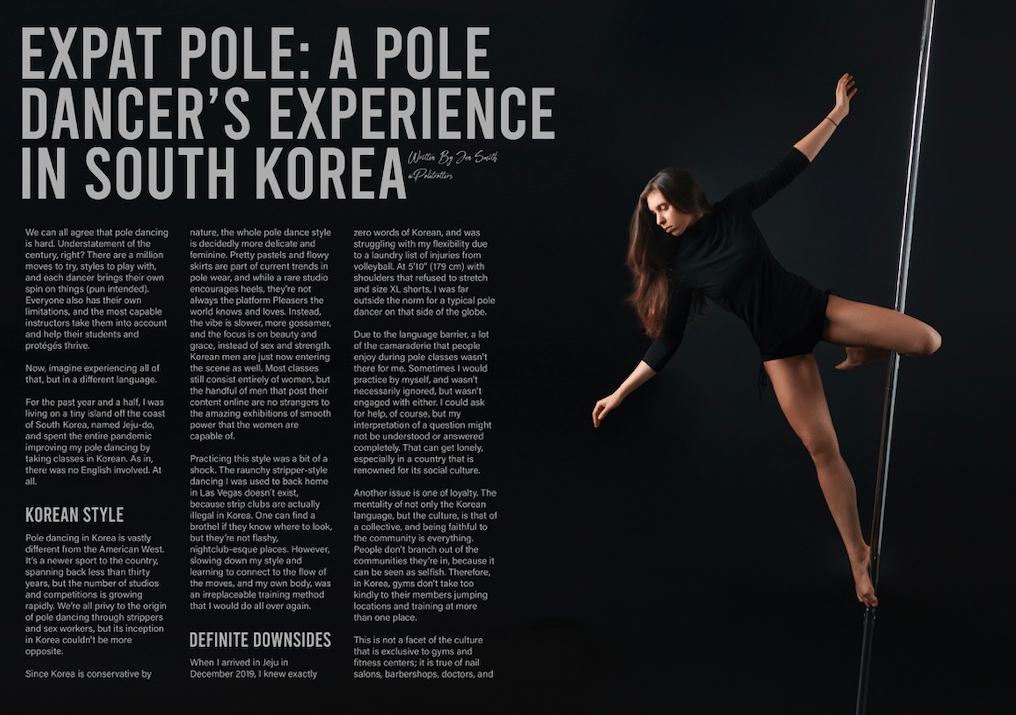
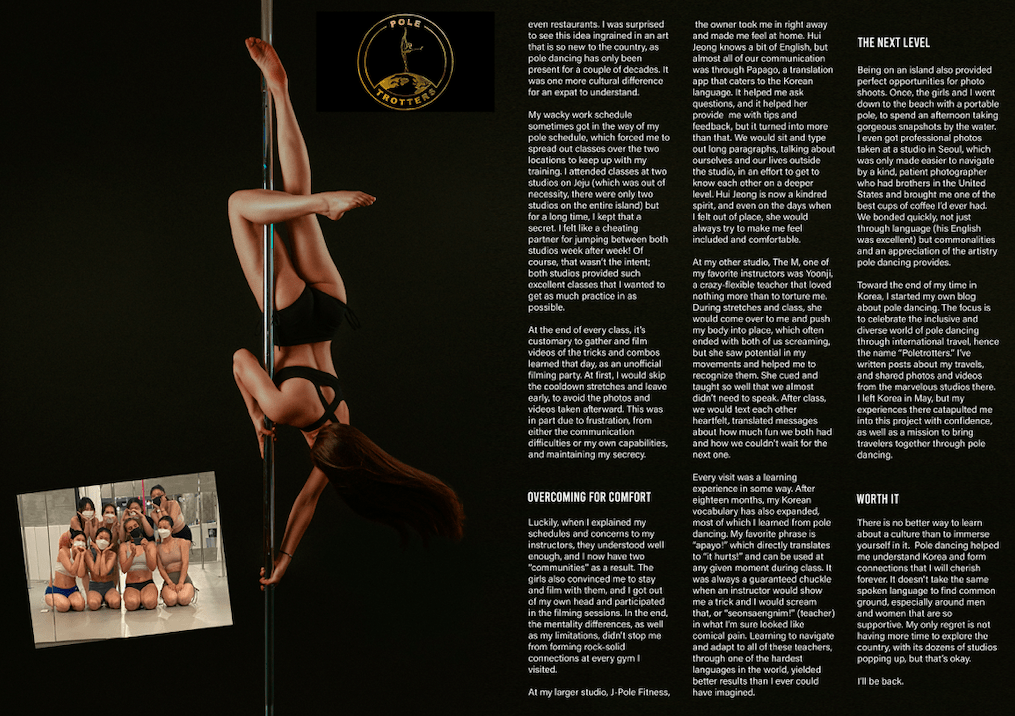
Expat Pole: A Pole Dancer’s Experience in South Korea
We can all agree that pole dancing is hard. Understatement of the century, right? There are a million moves to try, styles to play with, and each dancer brings their own spin on things (pun intended). Everyone also has their own limitations, and the most capable instructors take them into account and help their students and protégés thrive.
Now, imagine experiencing all of that, but in a different language.
For the past year and a half, I was stuck on a tiny island off the coast of South Korea, named Jeju-do, and spent the entire pandemic improving my pole dancing by taking classes in Korean. As in, there was no English involved. At all.
Korean style
Pole dancing in Korea is vastly different from the American West. It’s a newer sport to the country, spanning back less than thirty years, but the number of studios and competitions is growing rapidly. We’re all privy to the origin of pole dancing through strippers and sex workers, but its inception in Korea couldn’t be more opposite.
Since Korea is conservative by nature, the whole pole dance style is decidedly more delicate and feminine. Pretty pastels and flowy skirts are part of current trends in pole wear, and while a rare studio encourages heels, they’re not always the platform Hellas the world knows and loves. Instead the vibe is slower, more gossamer, and the focus is on beauty and grace, instead of sex and strength. Korean men are just now entering the scene as well. Most classes still consist entirely of women, but the handful of men that post their content online are no strangers to the amazing exhibitions of smooth power that the women are capable of.
Practicing this style was a bit of a shock. The raunchy stripper-style dancing I was used to back home in Las Vegas doesn’t exist, because strip clubs are actually illegal in Korea. One can find a brothel if they know where to look, but they’re not flashy, nightclub-esque places. However, slowing down my style and learning to connect to the flow of the moves, and my own body, was an irreplaceable training method that I would do all over again.
Definite downsides
When I arrived in Jeju in December 2019, I knew exactly zero words of Korean, and was struggling with my flexibility due to a laundry list of injuries from volleyball in school. At 5’10” (179 cm) with shoulders that refused to hold my body weight and size XL shorts, I was far outside the norm for a typical pole dancer on that side of the globe.
Due to the language barrier, a lot of the camaraderie that people enjoy during pole classes wasn’t there for me. Sometimes I would practice by myself, and wasn’t necessarily ignored, but wasn’t engaged with either. I could ask for help, of course, but my interpretation of a question might not be understood, or answered completely. That can get lonely, especially in a country that is renowned for its social culture.
Another issue is one of loyalty. The mentality of not only the language, but the culture, is that of a collective, and being faithful to the community is everything. People don’t branch out of the communities they’re in, because it can be seen as selfish. Therefore, in Korea, gyms don’t take too kindly to their members jumping locations and training at more than one place.
This is not a facet of the culture that is exclusive to gyms and fitness centers; it is true of nail salons, barbershops, doctors, and even restaurants. I was surprised to see this idea ingrained in an art that is so new to the country, as pole dancing has only been present for a couple of decades. It was one more cultural difference for an expat to understand.
My wacky work schedule sometimes got in the way of my pole schedule, which forced me to spread out classes over the two locations to keep up with my training. I attended classes at two studios on Jeju (which was out of necessity, there were only two studios on the entire island) but for a long time, I kept that a secret. I felt like a cheating partner for jumping between both studios week after week! Of course, that wasn’t the intent; both studios provided such excellent classes that I wanted to get as much practice in as possible.
At the end of every class, it’s customary to gather and film videos of the tricks and combos learned that day, as an unofficial filming party. At first, I would skip the cooldown stretches and leave early, to avoid the photos and videos taken afterward. This was in part due to frustration, from either the communication difficulties or my own capabilities, and maintaining my secrecy.
Overcoming for Comfort
Luckily, when I explained my schedules and concerns to my instructors, they understood well enough, and I now have two “communities” as a result. The girls also convinced me to stay and film with them, and I got out of my own head and participated in the filming sessions. In the end, the mentality differences, as well as my limitations, didn’t stop me from forming rock-solid connections at every gym I visited.
At my larger studio, J-Pole Fitness, the owner took me in right away and made me feel at home. Hui Jeong knows a bit of English, but almost all of our communication was through Papago, a translation app that caters to the Korean language. It helped me ask questions, and it helped her provide me with tips and feedback, but it turned into more than that. We would sit and type out long paragraphs, talking about ourselves and our lives outside the studio, in an effort to get to know each other on a deeper level. Hui Jeong is now a kindred spirit, and even on the days when I felt out of place, she would always try to make me feel included and comfortable.
At my other studio, The M, one of my favorite instructors was Yoonji, a crazy-flexible teacher that loved nothing more than to torture me. During stretches and class, she would come over to me and push my body into place, which often ended with both of us screaming, but she saw potential in my movements and helped me to recognize them. She cued and taught so well that we almost didn’t need to speak. After class, we would text each other heartfelt, translated messages about how much fun we both had and how we couldn’t wait for the next one.
Every visit was a learning experience in some way. After eighteen months, my Korean vocabulary has also expanded, most of which I learned from pole dancing. My favorite phrase is “apayo!” which directly translates to “it hurts!” and can be used at any given moment during class. It was always a guaranteed chuckle when an instructor would show me a trick and I would scream that, or “seonsaengnim!” (teacher) in what I’m sure looked like comical pain. Learning to navigate and adapt to all of these teachers, through one of the hardest languages in the world, yielded better results than I ever could have imagined.
The Next Level
Being on an island also provided perfect opportunities for photo shoots. Once, the girls and I went down to the beach with a portable pole, to spend an afternoon taking gorgeous snapshots by the water. I even got professional photos taken at a studio in Seoul, which was only made easier to navigate by a kind, patient photographer who had brothers in the United States and brought me one of the best cups of coffee I’d ever had. We bonded quickly, not just through language (his English was excellent) but commonalities and an appreciation of the artistry pole dancing provides.
Toward the end of my time in Korea, I started my own blog about pole dancing. The focus is to celebrate the inclusive and diverse world of pole dancing through international travel, hence the name “Poletrotters.” I’ve written posts about my travels, and shared photos and videos from the marvelous studios there. I left Korea in May, but my experiences there catapulted me into this project with confidence, as well as a mission to bring travelers together through pole dancing.
Worth It
There is no better way to understand a culture than to immerse yourself in it. Pole dancing helped me understand Korea and form connections that I will cherish forever. It doesn’t take the same spoken language to find common ground, especially around men and women that are so supportive. My only regret is not having more time to explore the country, with its dozens of studios popping up, but that’s okay.
I’ll be back.
september 2021 issue 08
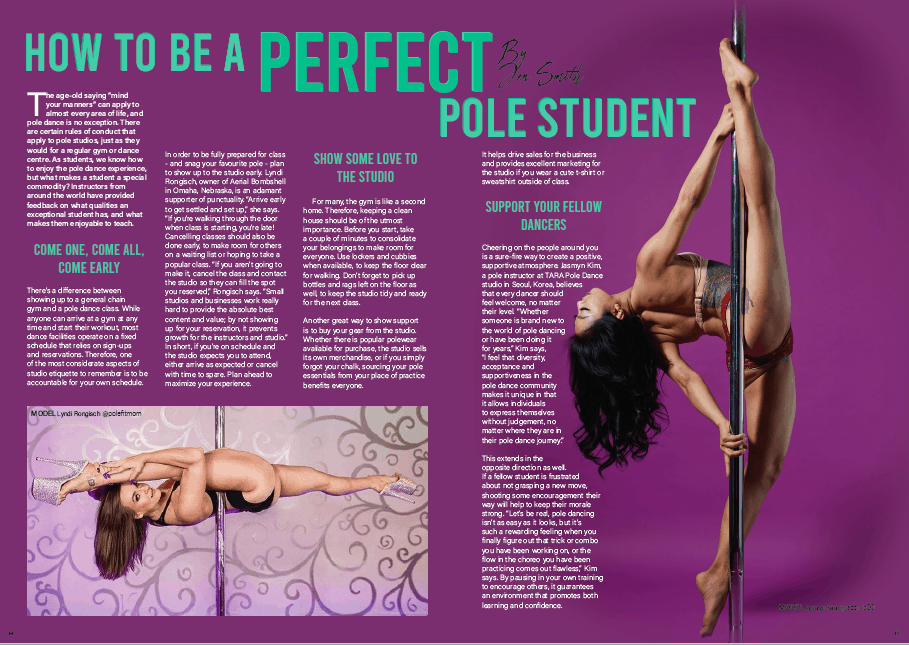
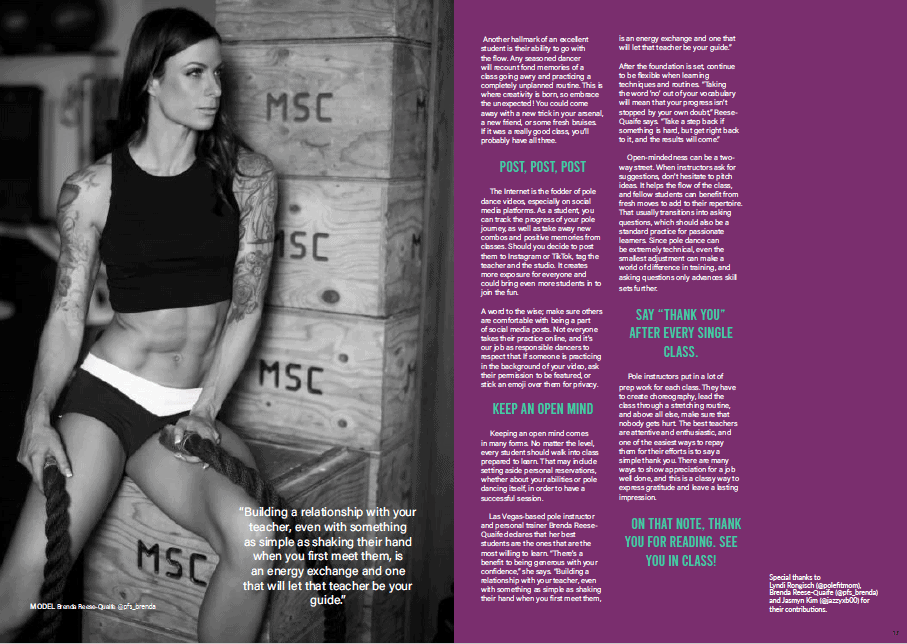
how to be a perfect pole student
The age-old saying “mind your manners” can apply to almost every area of life. There are certain rules of conduct that apply to pole studios, just as they would for a regular gym or dance center. As students, we know how to enjoy the pole dance experience, but what makes a student a special commodity? Instructors from around the world have provided feedback on what qualities an exceptional student has, and what makes them enjoyable to teach.
Come one, come all, come early
There’s a difference between showing up to a general chain gym and a pole dance class. While anyone can arrive at a gym at any time and start their workout, most dance facilities operate on a fixed schedule that relies on sign-ups and reservations. Therefore, one of the most considerate aspects of studio etiquette to remember is to be accountable for your own schedule.
In order to be fully prepared for class – and snag your favorite pole – plan to show up to the studio early. Lyndi Rongisch, owner of Aerial Bombshell in Omaha, Nebraska, is an adamant supporter of punctuality. “Arrive early to get settled and set up,” she says. “If you’re walking through the door when class is starting, you’re late!”
Canceling classes should also be done early, to make room for others on a waiting list or hoping to take a popular class. “If you aren’t going to make it, cancel the class and contact the studio so they can fill the spot you reserved,” Rongisch says. “Small studios and businesses work really hard to provide the absolute best content and value; by not showing up for your reservation, it prevents growth for the instructors and studio.”
In short, if you’re on schedule and the studio expects you to attend, either arrive as expected or cancel with time to spare. Plan ahead to maximize your experience.
Show some love to the studio
For many, the gym is like a second home. Therefore, keeping a clean house should be of the utmost importance. Before you start, take a couple of minutes to consolidate your belongings to make room for everyone. Use lockers and cubbies when available, to keep the floor clear for walking. Don’t forget to pick up bottles and rags left on the floor as well, to keep the studio tidy and ready for the next class.
Another great way to show support is to buy your gear from the studio. Whether there is popular polewear available for purchase, the studio sells its own merchandise, or if you simply forgot your chalk, sourcing your pole essentials from your place of practice benefits everyone. It helps drive sales for the business, and provides excellent marketing for the studio if you wear a cute t-shirt or sweatshirt outside of class.
Support your fellow dancers
Cheering on the people around you is a surefire way to create a positive, supportive atmosphere. Jasmyn Kim, a pole instructor at TARA Pole Dance studio in Seoul, Korea, believes that every dancer should feel welcome, no matter their level. “Whether someone is brand new to the world of pole dancing or have been doing it for years,” Kim says, “I feel that diversity, acceptance and supportiveness in the pole dance community makes it unique in that it allows individuals to express themselves without judgement, no matter where they are in their pole dance journey.”
This extends in the opposite direction as well. If a fellow student is frustrated about not grasping a new move, shooting some encouragement their way will help to keep their morale strong. “Let’s be real, pole dancing isn’t as easy as it looks, but it’s such a rewarding feeling when you finally figure out that trick or combo you have been working on, or the flow in the choreo you have been practicing comes out flawless,” Kim says. By pausing in your own training to encourage others, it guarantees an environment that promotes both learning and confidence.
Another hallmark of an excellent student is their ability to go with the flow. Any seasoned dancer will recount fond memories of a class going awry and practicing a completely unplanned routine. This is where creativity is born, so embrace the unexpected! You could come away with a new trick in your arsenal, a new friend, or some fresh bruises. If it was a really good class, you’ll probably have all three.
Post, post, post
The Internet is the fodder of pole dance videos, especially on social media platforms. As a student, you can track the progress of your pole journey, as well as take away new combos and positive memories from classes. Should you decide to post them to Instagram or Tiktok, tag the teacher and the studio. It creates more exposure for everyone, and could bring even more students in to join the fun.
A word to the wise; make sure others are comfortable with being a part of social media posts. Not everyone takes their practice online, and it’s our job as responsible dancers to respect that. If someone is practicing in the background of your video, ask their permission to be featured, or stick an emoji over them for privacy.
Keep an open mind
Keeping an open mind comes in many forms. No matter the level, every student should walk into class prepared to learn. That may include setting aside personal reservations, whether about your abilities or pole dancing itself, in order to have a successful session.
Las Vegas-based pole instructor and personal trainer Brenda Reese-Quaife declares that her best students are the ones that are the most willing to learn. “There’s a benefit to being generous with your confidence,” she says. “Building a relationship with your teacher, even with something as simple as shaking their hand when you first meet them, is an energy exchange and one that will let that teacher be your guide.”
After the foundation is set, continue to be flexible when learning techniques and routines. “Taking the word ‘no’ out of your vocabulary will mean that your progress isn’t stopped by your own doubt,” Reese-Quaife says. “Take a step back if something is hard, but get right back to it, and the results will come.”
Open-mindedness can be a two-way street. When instructors ask for suggestions, don’t hesitate to pitch ideas. It helps the flow of the class, and fellow students can benefit from fresh moves to add to their repertoire. That usually transitions into asking questions, which should also be a standard practice for passionate learners. Since pole dance can be extremely technical, even the smallest adjustment can make a world of difference in training, and asking questions only advances skill sets further.
Say “thank you” after every single class.
Pole instructors put in a lot of prep work for each class. They have to create choreography, lead you through a stretching routine, and above all else, make sure that nobody gets hurt. The best teachers are attentive and enthusiastic, and one of the easiest ways to repay them for their efforts is to say a simple thank you. There are many ways to show appreciation for a job well done, and this is a classy way to express gratitude and leave a lasting impression.
On that note, thank you for reading. See you in class!
Special thanks to Lyndi Rongisch, Brenda Reese-Quaife, and Jasmyn Kim for their contributions.
october 2021 issue 09
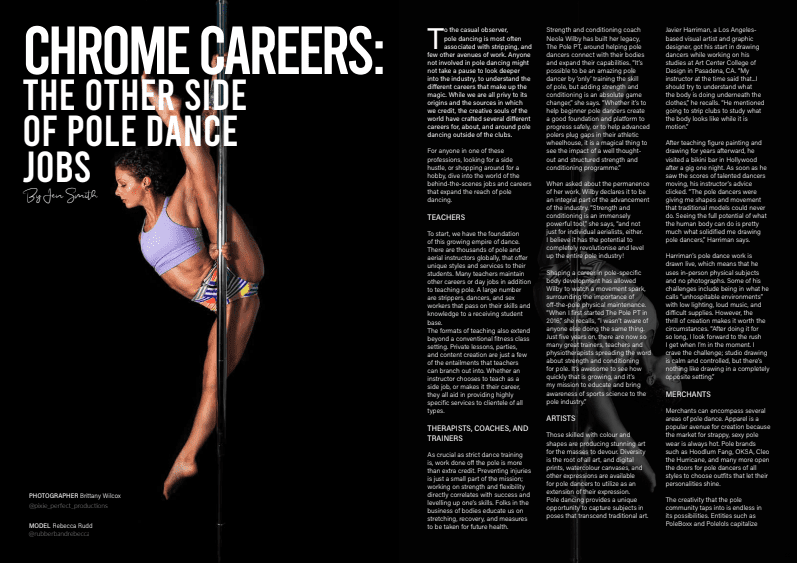
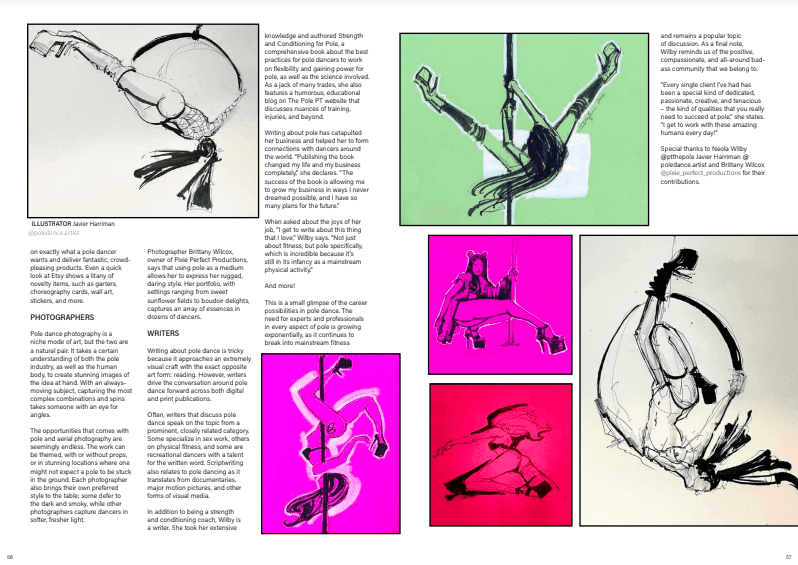
Chrome Careers: The Other Side of pole dance jobs
To the casual observer, pole dancing is most often associated with a singular avenue of work: stripping. Anyone not involved in pole dancing might not take a pause to look deeper into the industry, to understand the different careers that make up the magic. While we are all privy to its origins and the sources in which we credit, the creative souls of the world have crafted several different careers for, about, and around pole dancing outside of the clubs.
For anyone in one of these professions, looking for a side hustle, or shopping around for a hobby, dive into the world of the behind-the-scenes jobs and careers that expand the reach of pole dancing.
Teachers
To start, we have the foundation of this growing empire of dance. Similar to writers, many teachers maintain other careers or day jobs in addition to teaching pole. A large number are strippers, dancers, and sex workers that pass on their skills and knowledge to a receiving student base.
There are thousands of pole and aerial instructors globally, that offer unique styles and services to their students. Private lessons, parties, and content creation are just a few of the entailments that teachers can branch out into. Whether an instructor chooses to teach as a side job, or makes it their career with a studio, they all aid to bringing pole into the mainstream.
Therapists, Coaches, and Trainers
As crucial as strict dance training is, work done off of the pole is more than extra credit. Preventing injuries is just a small part of the mission; working on strength and flexibility directly correlates with success and leveling up one’s skills. Folks in the business of bodies educate us on stretching, recovery, and preventative measures to be taken for future health.
Strength and conditioning coach Neola Wilby has built her legacy on helping pole dancers connect with their bodies and expand their capabilities. “It’s possible to be an amazing pole dancer by ‘only’ training the skill of pole, but adding strength and conditioning is an absolute game changer,” she says. “Whether it’s to help beginner pole dancers create a good foundation and platform to progress safely, or to help advanced polers plug gaps in their athletic wheelhouse, it is a magical thing to see the impact of a well thought-out and structured strength and conditioning programme.”
When asked about the permanence of her work, Wilby declares it to be an integral part of the advancement of the industry. “Strength and conditioning is an immensely powerful tool,” she says, “ and not just for individual aerialists, either. I believe it has the potential to completely revolutionise and level up the entire pole industry!
Shaping a career in pole-specific body development has allowed Wilby to watch a movement spark, about the importance of off-the-pole physical maintenance. “When I first started The Pole PT in 2016,” she recalls, “I wasn’t aware of anyone else doing the same thing. Just five years on, there are now so many great trainers, teachers and physiotherapists spreading the word about strength and conditioning for pole. It’s awesome to see how quickly that is growing, and it’s my mission to educate and bring awareness of sports science to the pole industry.”
Artists
On the other hand, those skilled with color and shapes are producing stunning art for the masses to devour. Diversity is the root of all art, and digital prints, watercolor canvases, and other expressions are available for pole dancers. As a subject, pole dancing provides a unique opportunity to capture subjects in poses that transcend traditional art.
Javier Harriman, a Los Angeles-based visual artist and graphic designer, got his start in drawing dancers while working on his studies at Art Center College of Design in Pasadena, CA. “My instructor at the time said that…I should try to understand what the body is doing underneath the clothes,” he recalls. “He mentioned going to strip clubs to study what the body looks like while it is motion.”
After teaching figure painting and drawing for years afterward, he visited a bikini bar in Hollywood after a gig one night. As soon as he saw the scores of talented dancers moving, and his instructor’s advice clicked. “The pole dancers were giving me shapes and movement that traditional models could never do. Seeing the full potential of what the human body can do is pretty much what solidified me drawing pole dancers,” he says.
Javier’s pole dance work is drawn live, which means that he uses in-person physical subjects and no photographs. Some of his challenges include being in what he calls an “unhospitable environment” with low lighting, loud music, and difficult supplies. However, the thrill of creation makes it worth the circumstances. “After doing it for so long, I look forward to the rush I get when I’m in the moment. I crave the challenge; studio drawing is calm and controlled, but there’s nothing like drawing in a completely opposite setting.”
Merchants
Merchants can encompass several areas of pole dance. Apparel is a popular avenue for creation, because the market for strappy, sexy pole wear is always hot. Pole brands such as Hoodlum Fang, OKSA, Cleo the Hurricane, and many more open the doors for pole dancers of all styles to choose outfits that let their personalities shine.
The creativity that the pole community taps into is endless in its possibilities. Companies such as PoleBoxx and Polelols capitalize on exactly what a pole dancer wants and deliver fantastic, crowd-pleasing products. Even a quick look at Etsy shows a litany of novelty items, such as garters, choreography cards, wall art, stickers, and more.
Photographers
Pole dance photography is a niche mode of art, but the two are a natural pair. It takes a certain understanding of both the pole industry, as well as the human body, to create stunning images of the idea at hand. With an always-moving subject, capturing the most complex combinations and spins takes someone with an eye for angles.
The opportunity that comes with pole and aerial photography is seemingly endless. The work can be themed, with or without props, or in stunning locations where one might not expect a pole to be stuck in the ground. Each photographer also brings their own preferred style to the table; some defer to the dark and smoky, while other photographers capture dancers in softer, fresher light.
Photographer Brittany Wilcox, owner of Pixie Perfect Productions, says that using pole as a medium allows her to express her rugged, daring style. Her portfolio, with settings ranging from sweet sunflower fields to boudoir delights, captures an array of essences in dozens of dancers.
Writers
Writing about pole dance is tricky because it approaches an extremely visual craft with the exact opposite art form: reading. However, writers drive the conversation around pole dance forward across both digital and print publications.
Often, writers that discuss pole dance speak on the topic from a prominent, closely-related category. Some specialize in sex work, others on physical fitness, and some are recreational dancers with a talent for the written word. Scriptwriting also relates to pole dancing as it translates from documentaries, major motion pictures, and other forms of visual media.
In addition to being a strength and conditioning coach, Wilby took her extensive knowledge and authored Strength and Conditioning for Pole, a comprehensive book about the best practices for pole dancers to work on flexibility and gaining power for pole, as well as the science involved. As a jack of many trades, she also features a humorous, educational blog on her website that discusses finer nuances of training, injuries, and beyond.
Writing about pole has catapulted her business and helped her to form connections with dancers around the world. “Publishing the book changed my life and my business completely,” she declares. “The success of the book is allowing me to grow my business in ways I never dreamed possible and I have so many plans for the future.”
When asked about the joys of her job, “I get to write about this thing that I love,” Wilby says. “Not just about fitness, but pole specifically, which is incredible because it’s still in its infancy as a mainstream physical activity.”
And More!
This is a small glimpse of the career possibilities in pole dance. The need for experts and professionals in every aspect of pole is growing exponentially, as it continues to break into mainstream fitness and remains a popular topic of discussion. As a final note, Wilby reminds us of the positive, compassionate, and all-around badass community that we belong to.
“Every single client I’ve had has been a special kind of dedicated, passionate, creative, and tenacious – the kind of qualities that you really need to succeed at pole,” she proudly states. “I get to work with these amazing humans every day! I’ve celebrated so many happy ‘nailed it’ moments with my clients around the world and made so many friends along the way.”
February 2022 issue 12
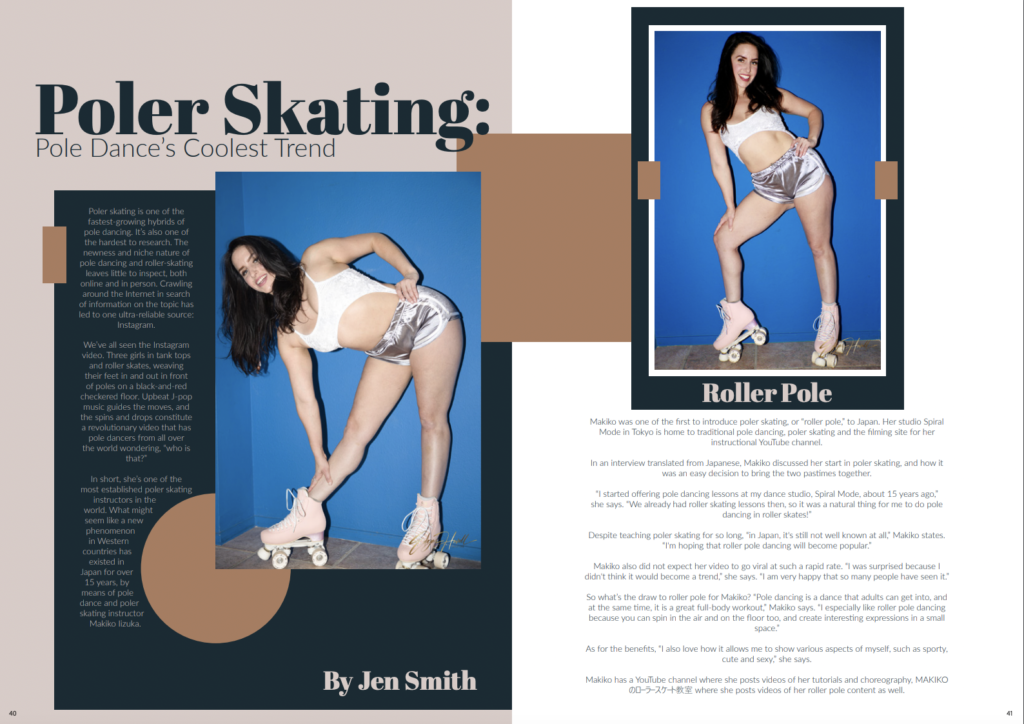
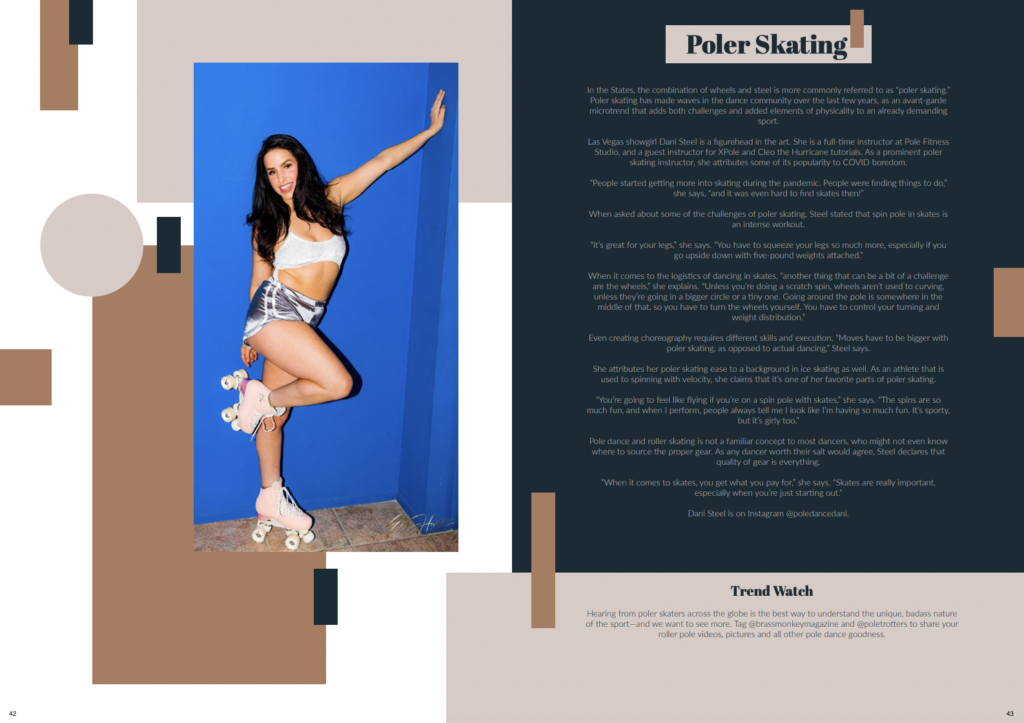
Poker Skating: Pole Dance’s Coolest Trend
Poler skating is one of the fastest-growing hybrids of pole dancing. It’s also one of the hardest to research. The newness and niche nature of pole dancing and roller-skating leaves little to inspect, both online and in person. Crawling around the Internet in search of information on the topic has led to one ultra-reliable source: Instagram.
We’ve all seen the Instagram video. Three girls in tank tops and roller skates, weaving their feet in and out in front of poles on a black-and-red checkered floor. Upbeat J-pop music guides the moves, and the spins and drops constitute a revolutionary video that has pole dancers from all over the world wondering, “who is that?”
In short, she’s one of the most established poler skating instructors in the world. What might seem like a new phenomenon in Western countries has existed in Japan for over 15 years, by means of pole dance and poler skating instructor Makiko Iizuka.
Roller Pole
Makiko was one of the first to introduce poler skating, or “roller pole,” to Japan. Her studio Spiral Mode in Tokyo is home to traditional pole dancing, poler skating and the filming site for her instructional YouTube channel.
In an interview translated from Japanese, Makiko discussed her start in poler skating, and how it was an easy decision to bring the two pastimes together.
“I started offering pole dancing lessons at my dance studio, Spiral Mode, about 15 years ago,” she says. “We already had roller skating lessons then, so it was a natural thing for me to do pole dancing in roller skates!”
Despite teaching poler skating for so long, “in Japan, it’s still not well known at all,” Makiko states. “I’m hoping that roller pole dancing will become popular.”
Makiko also did not expect her video to go viral at such a rapid rate. “I was surprised because I didn’t think it would become a trend,” she says. “I am very happy that so many people have seen it.”
So what’s the draw to roller pole for Makiko? “Pole dancing is a dance that adults can get into, and at the same time, it is a great full-body workout,” Makiko says. “I especially like roller pole dancing because you can spin in the air and on the floor too, and create interesting expressions in a small space.”
As for the benefits, “I also love how it allows me to show various aspects of myself, such as sporty, cute and sexy,” she says.
Makiko has a YouTube channel where she posts videos of her tutorials and choreography, MAKIKOのローラースケート教室 where she posts videos of her roller pole content as well.
Poler Skating
In the States, the combination of wheels and steel is more commonly referred to as “poler skating.” Poler skating has made waves in the dance community over the last few years, as an avant-garde microtrend that adds both challenges and added elements of physicality to an already demanding sport.
Las Vegas showgirl Dani Steel is a figurehead in the art. She is a full-time instructor at Pole Fitness Studio, and a guest instructor for XPole and Cleo the Hurricane tutorials. As a prominent poler skating instructor, she attributes some of its popularity to COVID boredom.
“People started getting more into skating during the pandemic. People were finding things to do,” she says, “and it was even hard to find skates then!”
When asked about some of the challenges of poler skating, Steel stated that spin pole in skates is an intense workout.
“It’s great for your legs,” she says. “You have to squeeze your legs so much more, especially if you go upside down with five-pound weights attached.”
When it comes to the logistics of dancing in skates, “another thing that can be a bit of a challenge are the wheels,” she explains. “Unless you’re doing a scratch spin, wheels aren’t used to curving, unless they’re going in a bigger circle or a tiny one. Going around the pole is somewhere in the middle of that, so you have to turn the wheels yourself. You have to control your turning and weight distribution.”
Even creating choreography requires different skills and execution. “Moves have to be bigger with poler skating, as opposed to actual dancing,” Steel says.
She attributes her poler skating ease to a background in ice skating as well. As an athlete that is used to spinning with velocity, she claims that it’s one of her favorite parts of poler skating.
“You’re going to feel like flying if you’re on a spin pole with skates,” she says. “The spins are so much fun, and when I perform, people always tell me I look like I’m having so much fun. It’s sporty, but it’s girly too.”
Pole dance and roller skating is not a familiar concept to most dancers, who might not even know where to source the proper gear. As any dancer worth their salt would agree, Steel declares that quality of gear is everything.
“When it comes to skates, you get what you pay for,” she says. “Skates are really important, especially when you’re just starting out.”
Dani Steel is on Instagram @poledancedani.
Trend Watch
Hearing from poler skaters across the globe is the best way to understand the unique, badass nature of the sport—and we want to see more. Tag @brassmonkeymagazine and @poletrotters to share your roller pole videos, pictures and all other pole dance goodness.